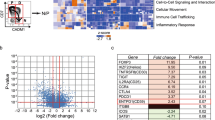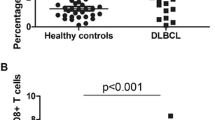Abstract
Chronic lymphocytic leukemia (CLL) cells depend on their microenvironment for proliferation and survival. Ectonucleotidase CD39 has anti-inflammatory properties as it hydrolyzes proinflammatory extracellular ATP, generates anti-inflammatory adenosine, and also protects regulatory T cells from ATP-induced cell death. In this study, we investigated the clinical significance of CD39 expression on CD4+ T cells in 62 patients with CLL as well as its compartmental regulation and explored the possible mechanisms for its induction. Compared to healthy individuals, CD4+CD39+ lymphocytes were increased in the peripheral blood of patients with CLL and correlated with the advanced stage of disease. CD4+CD39+ cells were also higher in patients with CLL, who needed therapeutic intervention, and in those who had unmutated immunoglobulin heavy chain variable region gene, were ZAP70+ or had β2-microglobulin levels of >3 g/L. There were more CD4+CD39+ lymphocytes in the bone marrow compartment than in the peripheral blood, and in vitro studies showed that CD39 can be induced on CD4+ cells by exposure to ATP or indirectly, following B cell receptor engagement. This may support the notion that the leukemic cells contribute to create an immune-subversive environment, and perhaps to a poorer prognosis. CD39+ may also serve as a future target for the development of novel therapies with immune-modulating antitumor agents in CLL.





Similar content being viewed by others
References
Byrd JC, Stilgenbauer S, Flinn IW (2004) Chronic lymphocytic leukemia. Hematology Am Soc Hematol Educ Program 163–183
Curiel TJ (2007) Tregs and rethinking cancer immunotherapy. J Clin Invest 117:1167–1174
Lapalombella R, Andritsos L, Liu Q et al (2010) Lenalidomide treatment promotes CD154 expression on CLL cells and enhances production of antibodies by normal B cells through a PI3-kinase-dependent pathway. Blood 115:2619–2629
Molica S (2007) Immunomodulatory drugs in chronic lymphocytic leukemia: a new treatment paradigm. Leuk Lymphoma 48:866–869
Ramsay AG, Johnson AJ, Lee AM et al (2008) Chronic lymphocytic leukemia T cells show impaired immunological synapse formation that can be reversed with an immunomodulating drug. J Clin Invest 118:2427–2437
Borsellino G, Kleinewietfeld M, Di Mitri D et al (2007) Expression of ectonucleotidase CD39 by Foxp3+ Treg cells: hydrolysis of extracellular ATP and immune suppression. Blood 110:1225–1232
Mizumoto N, Kumamoto T, Robson SC et al (2002) CD39 is the dominant Langerhans cell-associated ecto-NTPDase: modulatory roles in inflammation and immune responsiveness. Nat Med 8:358–365
Bours MJ, Swennen EL, Di Virgilio F et al (2006) Adenosine 5′-triphosphate and adenosine as endogenous signaling molecules in immunity and inflammation. Pharmacol Ther 112:358–404
Deaglio S, Dwyer KM, Gao W et al (2007) Adenosine generation catalyzed by CD39 and CD73 expressed on regulatory T cells mediates immune suppression. J Exp Med 204:1257–1265
Langston HP, Ke Y, Gewirtz AT et al (2003) Secretion of IL-2 and IFN-gamma, but not IL-4, by antigen-specific T cells requires extracellular ATP. J Immunol 170:2962–2970
Thiel M, Caldwell CC, Sitkovsky MV (2003) The critical role of adenosine A2A receptors in downregulation of inflammation and immunity in the pathogenesis of infectious diseases. Microbes Infect 5:515–526
Hilchey SP, Kobie JJ, Cochran MR et al (2009) Human follicular lymphoma CD39+-infiltrating T cells contribute to adenosine-mediated T cell hyporesponsiveness. J Immunol 183:6157–6166
Beyer M, Schultze JL (2006) Regulatory T cells in cancer. Blood 108:804–811
Darrasse-Jeze G, Deroubaix S, Mouquet H et al (2009) Feedback control of regulatory T cell homeostasis by dendritic cells in vivo. J Exp Med 206:1853–1862
Gobert M, Treilleux I, Bendriss-Vermare N et al (2009) Regulatory T cells recruited through CCL22/CCR4 are selectively activated in lymphoid infiltrates surrounding primary breast tumors and lead to an adverse clinical outcome. Cancer Res 69:2000–2009
Giannopoulos K, Schmitt M, Kowal M et al (2008) Characterization of regulatory T cells in patients with B-cell chronic lymphocytic leukemia. Oncol Rep 20:677–682
D'Arena G, Laurenti L, Minervini MM et al (2011) Regulatory T-cell number is increased in chronic lymphocytic leukemia patients and correlates with progressive disease. Leuk Res 35:363–368
Weiss L, Melchardt T, Egle A et al (2011) Regulatory T cells predict the time to initial treatment in early stage chronic lymphocytic leukemia. Cancer 117:2163–2169
Christopoulos P, Pfeifer D, Bartholome K et al (2011) Definition and characterization of the systemic T-cell dysregulation in untreated indolent B-cell lymphoma and very early CLL. J Am Soc Hematol 117(14):3836–3846
Aswad F, Kawamura H, Dennert G (2005) High sensitivity of CD4+CD25+ regulatory T cells to extracellular metabolites nicotinamide adenine dinucleotide and ATP: a role for P2X7 receptors. J Immunol 175:3075–3083
Moncrieffe H, Nistala K, Kamhieh Y et al (2010) High expression of the ectonucleotidase CD39 on T cells from the inflamed site identifies two distinct populations, one regulatory and one memory T cell population. J Immunol 185:134–143
Hallek M, Cheson BD, Catovsky D et al (2008) Guidelines for the diagnosis and treatment of chronic lymphocytic leukemia: a report from the International Workshop on Chronic Lymphocytic Leukemia updating the National Cancer Institute-Working Group 1996 guidelines. Blood 111:5446–5456
Mao Z, Quintanilla-Marti L, Raffeld M et al (2007) IgVH mutational status and clonality analysis of Richter's transformation: diffuse large B-cell lymphoma and Hodgkin lymphoma in association with B-cell chronic lymphocytic leukemia (B-CLL) represent 2 different pathways of disease evolution. Am J Surg Pathol 31:1605–1614
Herishanu Y, Perez-Galan P, Liu D et al (2011) The lymph node microenvironment promotes B-cell receptor signaling, NF-kappaB activation, and tumor proliferation in chronic lymphocytic leukemia. Blood 117:563–574
Crespo M, Bosch F, Villamor N et al (2003) ZAP-70 expression as a surrogate for immunoglobulin-variable-region mutations in chronic lymphocytic leukemia. N Engl J Med 348:1764–1775
Sun X, Wu Y, Gao W et al (2010) CD39/ENTPD1 expression by CD4+Foxp3+ regulatory T cells promotes hepatic metastatic tumor growth in mice. Gastroenterology 139(3):1030–1040
Ghia P, Strola G, Granziero L et al (2002) Chronic lymphocytic leukemia B cells are endowed with the capacity to attract CD4+, CD40L+ T cells by producing CCL22. Eur J Immunol 32:1403–1413
Ohta A, Gorelik E, Prasad SJ et al (2006) A2A adenosine receptor protects tumors from antitumor T cells. Proc Natl Acad Sci U S A 103:13132–13137
Blay J, White TD, Hoskin DW (1997) The extracellular fluid of solid carcinomas contains immunosuppressive concentrations of adenosine. Cancer Res 57:2602–2605
Gorini S, la Sala A (2008) Hydrolysis of extracellular ATP and immune suppression: humans versus mice. Blood 111:965–966
Pulte D, Furman RR, Broekman MJ et al (2011) CD39 expression on T lymphocytes correlates with severity of disease in patients with chronic lymphocytic leukemia. Clin Lymphoma Myeloma Leukemia 4:367–372
Quiroga MP, Balakrishnan K, Kurtova AV et al (2009) B-cell antigen receptor signaling enhances chronic lymphocytic leukemia cell migration and survival: specific targeting with a novel spleen tyrosine kinase inhibitor, R406. Blood 114:1029–1037
Acknowledgment
This work was supported by a grant from the Eldor-Matzner award, Chief Scientist Office, Israel Ministry of Health.
Author information
Authors and Affiliations
Corresponding author
Additional information
Chava Perry and Inbal Hazan-Halevy equally contributed to this work.
Electronic supplementary material
Below is the link to the electronic supplementary material.
Supplement 1
Consecutive measurements of %CD4+CD39+ lymphocytes in individual CLL patients (DOCX 26 kb)
Rights and permissions
About this article
Cite this article
Perry, C., Hazan-Halevy, I., Kay, S. et al. Increased CD39 expression on CD4+ T lymphocytes has clinical and prognostic significance in chronic lymphocytic leukemia. Ann Hematol 91, 1271–1279 (2012). https://doi.org/10.1007/s00277-012-1425-2
Received:
Accepted:
Published:
Issue Date:
DOI: https://doi.org/10.1007/s00277-012-1425-2




